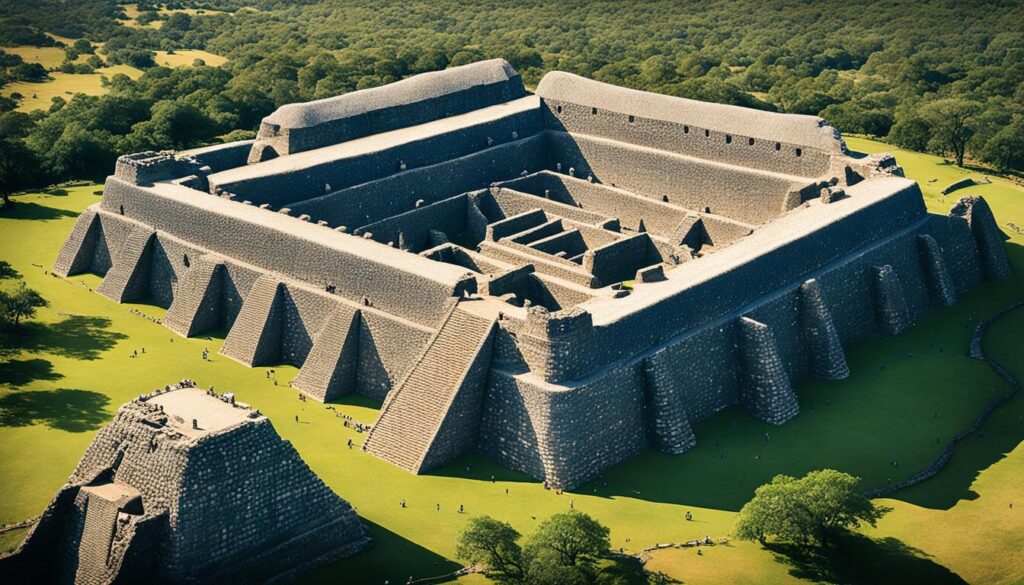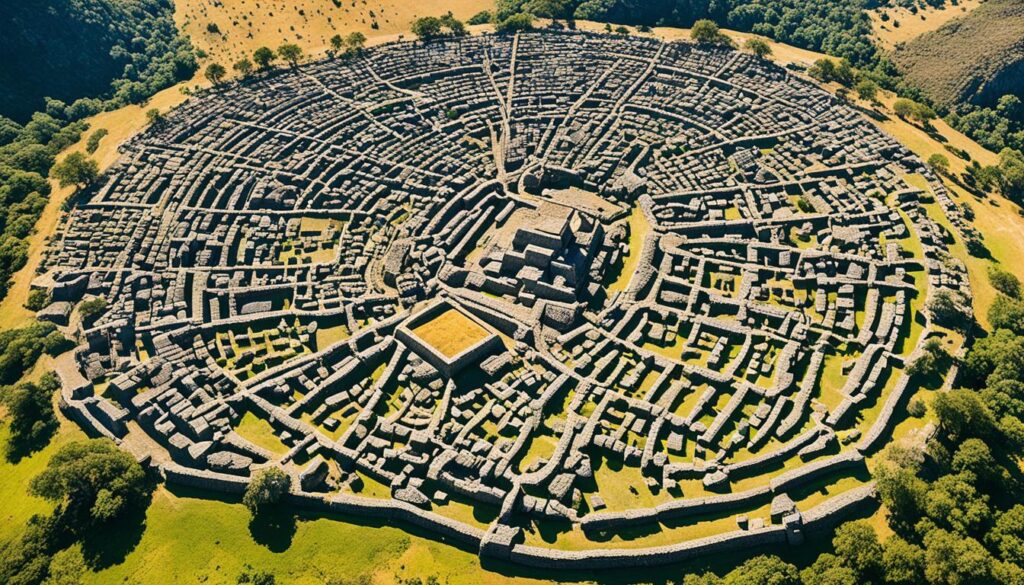In southeastern Zimbabwe, the Great Zimbabwe ruins sit in the hills. They show off the amazing work of an old African civilization. This place, now a UNESCO World Heritage Site, has caught the interest of many. It gives us a peek into the culture and architecture of pre-colonial Africa.
The Great Zimbabwe was once a key city in a medieval kingdom. It’s known for its tall tower and detailed stone work. Built without mortar, this city shows the skill of its people. They used the area’s resources to make a center of trade and culture.
The Great Zimbabwe is full of mysteries and wonders. It has soapstone birds and underground tunnels. Each part of it tells us about the lively civilization that once thrived here.
Let’s dive into the Great Zimbabwe’s history. We’ll look at the mysteries that have drawn scholars and fans. We’ll see how this African kingdom became a key player in the region.
Unveiling the Mysteries of Great Zimbabwe
The Great Zimbabwe ruins have always fascinated historians, archaeologists, and visitors. This ancient stone city is in southern Africa. It shows the amazing skills of the people who lived there long ago. The site has huge dry-stone walls and detailed masonry, making it a key archaeological site.
Ancient Ruins Steeped in History
The Great Zimbabwe ruins are full of history. They give us a peek into the culture of the area. The site has towers, platforms, and enclosures made with local materials. These show the cleverness and hard work of the old builders.
Scholars have worked hard to uncover the secrets of these ruins. They want to learn about the social, political, and economic life of the African kingdom that was here.
Architectural Marvel of Southern Africa
The stone city of Great Zimbabwe is an amazing architectural wonder. It challenges our ideas of ancient African buildings. The site uses dry-stone walls, has detailed patterns, and is very big.
This has made people wonder and study it a lot. Scholars are trying to figure out how the people built this incredible stone city.
Historical Curiosities
The Great Zimbabwe ruins are a fascinating look into ancient African kingdoms. They show us the amazing achievements of old African kingdoms. This site, in southern Africa, has been studied and admired for years.
Scholars and visitors are drawn to its architecture and culture. Great Zimbabwe is a key archaeological wonder in Africa. It helps us understand the rich culture and history of pre-colonial Africa.
The site has towering stone buildings, detailed patterns, and mysterious carvings. These features give us hints about the kingdom’s history. They make us wonder about the stories of the past.
For those interested in Africa’s cultural heritage, Great Zimbabwe is a must-see. It lets us explore the history of a powerful kingdom. The site shows off its grand architecture and mysterious symbols. It’s a captivating look into the past.
The Rise of a Powerful African Civilization
The Great Zimbabwe kingdom started as a small farming community in the 11th century. It grew into a powerful force in southern Africa. This ancient civilization was strong because of its location, farming skills, and wide trade networks. These helped it become wealthy and influential in the region.
Origins and Growth of the Kingdom
A small farming community began in southern Africa in the early 11th century. Over time, it grew and became a key center for trade. The kingdom’s success came from its farming success, which supported a wide trade network.
This network connected Great Zimbabwe to other African civilizations and the world. The kingdom’s location was perfect for trade. It was close to valuable resources like gold and ivory. This made it a key player in southern Africa’s trade.
Exploring the Stone City’s Grandeur
The Great Zimbabwe ruins show off the amazing skills of an ancient African kingdom. The site’s famous tower, the “Great Enclosure,” is a key example of their engineering skills. The detailed dry-stone walls and buildings across the site still amaze and draw in visitors.
The architecture of Great Zimbabwe is truly amazing. It highlights the site’s cultural importance. The use of dry-stone masonry shows the builders’ skill and creativity. These stone buildings, made with great care, have lasted for centuries. They prove the advanced building skills of the kingdom’s people.

Walking through the ruins, you can see the detailed design of the stone city. You’ll be amazed by how living areas, government buildings, and spiritual sites blend together smoothly. The Great Enclosure, with its unique tower, is especially striking. It shows the technical skill and beauty sense of the Great Zimbabwe people.
Today, the stone city’s architecture still stuns visitors and helps us understand the area’s deep cultural history. As a UNESCO World Heritage Site, Great Zimbabwe ruins keep inspiring and captivating people worldwide. They offer a peek into the impressive achievements of this ancient African kingdom.
Decoding the Enigmatic Soapstone Bird Carvings
The Great Zimbabwe site has many treasures, but the soapstone bird carvings stand out. These sculptures are found all over the ancient city. They have always fascinated scholars and fans, showing us the deep symbols and beliefs of the Great Zimbabwe people.
These bird carvings were very important to the kingdom’s leaders and people. Scholars think they might have been totemic figures, royal symbols, or spiritual beings. The skill in making these shows how talented the Great Zimbabwe artists were. They turned soapstone into symbols of African culture.
Symbols of Royalty and Spirituality
The soapstone birds found at Great Zimbabwe are seen as symbols of the Zimbabwe bird. This bird is a legendary creature that symbolizes the kingdom’s culture. The birds have detailed patterns and features. They show the power, authority, and spiritual importance of the rulers and the kingdom’s beliefs.
By studying these symbols, researchers learn more about the Great Zimbabwe civilization. They uncover the kingdom’s artistic and spiritual traditions. These artifacts prove the creativity, skill, and cultural legacy of the Great Zimbabwe people. They continue to amaze the world with their lasting art and symbols.
Trade Routes and Economic Prowess
The Great Zimbabwe kingdom became powerful because of its strategic location and economic strength. It was at the center of African trade before the colonial era. The kingdom’s trade routes linked it to the Indian Ocean and the trans-Saharan region. This brought it a lot of wealth and influence.
The kingdom’s trade and economic power shaped southern Africa’s culture and politics. Its success was a big part of its story.
Great Zimbabwe’s Commercial Influence
The kingdom traded goods like gold, ivory, and luxury items. These trade routes made the kingdom prosperous and helped spread culture and ideas. It became a key place for trade in southern Africa.

The kingdom was more than just a trading center. It had advanced farming and manufacturing too. This made it a strong and lasting presence in the region. The kingdom’s success shows the skill and strength of African civilizations before colonial times.
Unraveling the Mystery of Abandonment
The Great Zimbabwe, once a thriving African kingdom, is now a mystery. Scholars have many theories about why it declined and was abandoned. Each theory offers clues about what led to its downfall.
One popular theory is about environmental factors. Experts believe that long droughts, using up resources, and climate changes made life hard for the kingdom. These issues might have made it hard for the people to live and work there. So, they might have left to find better places.
Another theory looks at sociopolitical changes. The kingdom’s rise could have caused problems with nearby groups. Also, power struggles within the kingdom might have led to its downfall. Historians are still looking into these theories to understand what happened.
Even though we’re still trying to figure out why Great Zimbabwe was abandoned, its ruins show the skill and strength of its people. The factors that led to its decline make us value the achievements of this ancient kingdom even more.
Archaeological Excavations and Discoveries
At the Great Zimbabwe site, archaeologists have found many ancient artifacts and cultural treasures. These finds give us a peek into the kingdom’s history and daily life. They include things like soapstone carvings, jewelry, and household items.
Archaeologists and historians have worked hard to uncover these artifacts. They’ve found soapstone figurines that show the kingdom’s spiritual beliefs and royal power. The jewelry, made of gold and other precious materials, shows the kingdom’s wealth and the skill of its craftsmen.
But it’s not just about the fancy items. The digs have also turned up everyday things like pottery, tools, and utensils. These items help us see what life was like for the people of Great Zimbabwe. By studying them closely, we learn more about their society, economy, and culture.






